Publications

CJJR sponsors papers developed from a cross-system perspective on cutting-edge issues in the fields of juvenile justice, child welfare and related systems of care. Past papers have focused on crossover youth, racial and ethnic disproportionality, and improving educational outcomes, among other topics. The Center hosts symposia to facilitate discussion about the papers among policymakers and practitioners from around the country.
Supporting High-Needs Youth at Home and in the Community: Implementation of Youth Advocate Programs, Inc.’s Core Model in Six Jurisdictions Across the United States
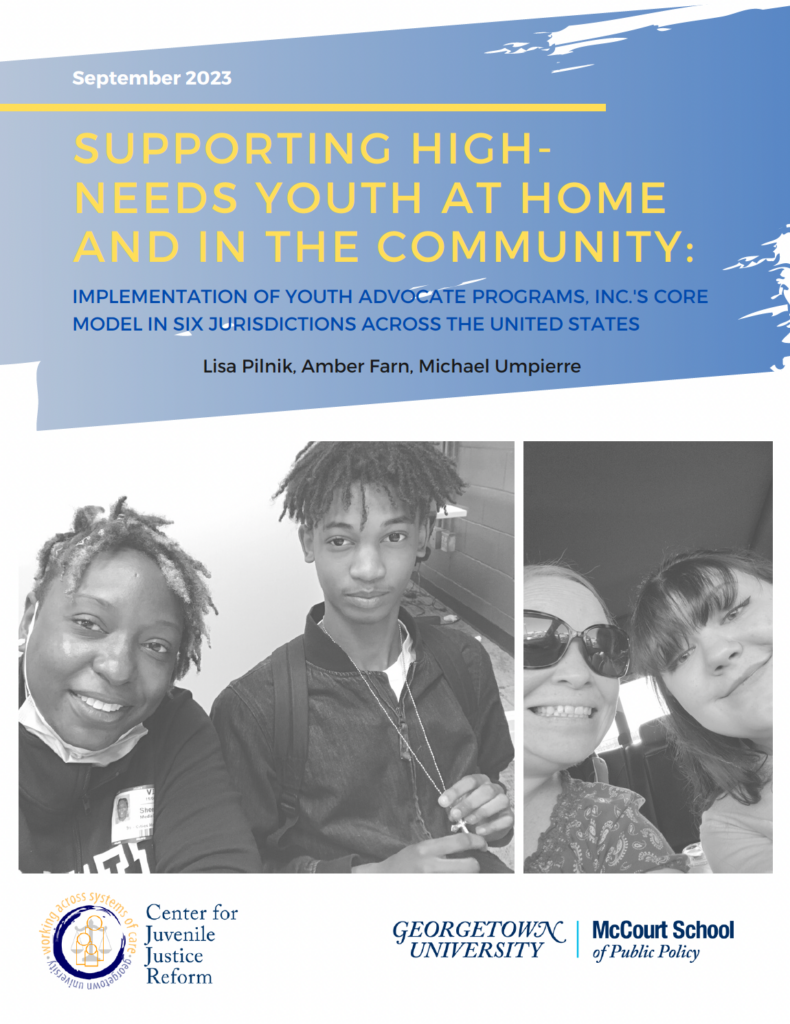
CJJR is pleased to release a new publication authored by Lisa Pilnik, Amber Farn, and Michael Umpierre, with support from Youth Advocate Programs, Inc. (YAP). The report highlights strategies to keep high-needs youth involved in the legal system within their communities.
Through YAP’s Safely Home Initiative, six jurisdictions implemented YAP in their communities, including Yavapai County, Arizona; Alameda County, California; Fulton County, Georgia; Mecklenburg County, North Carolina; Hamilton County, Ohio, and the state of Illinois. The publication details the strategies, impact, and outcomes resulting from the implementation of the YAP Safely Home Initiative in these six communities. Policymakers, youth justice agency leaders, and others interested in supporting community-based services and alternatives to youth incarceration are encouraged to read this new resource for the field.
Advancing Racial Equity in Pennsylvania’s Youth Legal System

The Center for Juvenile Justice Reform, in partnership with Stoneleigh Foundation, presents, “Advancing Racial Equity in Pennsylvania’s Youth Legal System.” Authored by Stoneleigh Emerging Leader, Dr. Meghan Ogle, this report details the work of seven county-based teams (representing Allegheny, Chester, Lancaster, Lehigh, Montgomery, Philadelphia, and York Counties) and one state-based team in Pennsylvania who participated in CJJR’s Advancing Racial Equity and Justice in Youth Legal Systems Certificate Program in September of 2021. After engaging in the weeklong Certificate Program in Harrisburg, Pennsylvania, these multi-disciplinary teams of youth legal system officials and partners developed Capstone Projects designed to advance racial equity and reduce disparities faced by youth of color involved in the youth legal system. This report details the Capstone Projects developed by each of the teams, baseline data analyzed, implementation progress, and initial outcome measures. It also highlights lessons learned in the process, including common challenges faced by the participating sites, as well as promising strategies.
Strategies for Addressing Length of Stay to Improve Outcomes for Youth and Communities: Lessons Learned from the Length of Stay Policy Academy

Authored in partnership with the Council of Juvenile Justice Administrators (CJJA) and with support from The Pew Charitable Trusts (Pew), this publication provides an overview of research related to length of stay and lessons learned from the Length of Stay Policy Academy hosted by CJJR and CJJA in 2020 with support from Pew.
The report features length of stay efforts from the jurisdictions that participated in the Academy, including Bexar County, Texas; Idaho; Maryland; New York City, New York; and Oklahoma, as well as other states that have led related initiatives such as Arkansas, Illinois, and Utah. Policymakers, youth justice agency leaders, facility-based staff, and others interested in examining their jurisdictions’ lengths of stay policies and practices are encouraged to read this resource for the field.
Common Problems, Common Solutions: Looking Across Sectors at Strategies for Supporting Rural Youth and Families Tool-Kit
2023
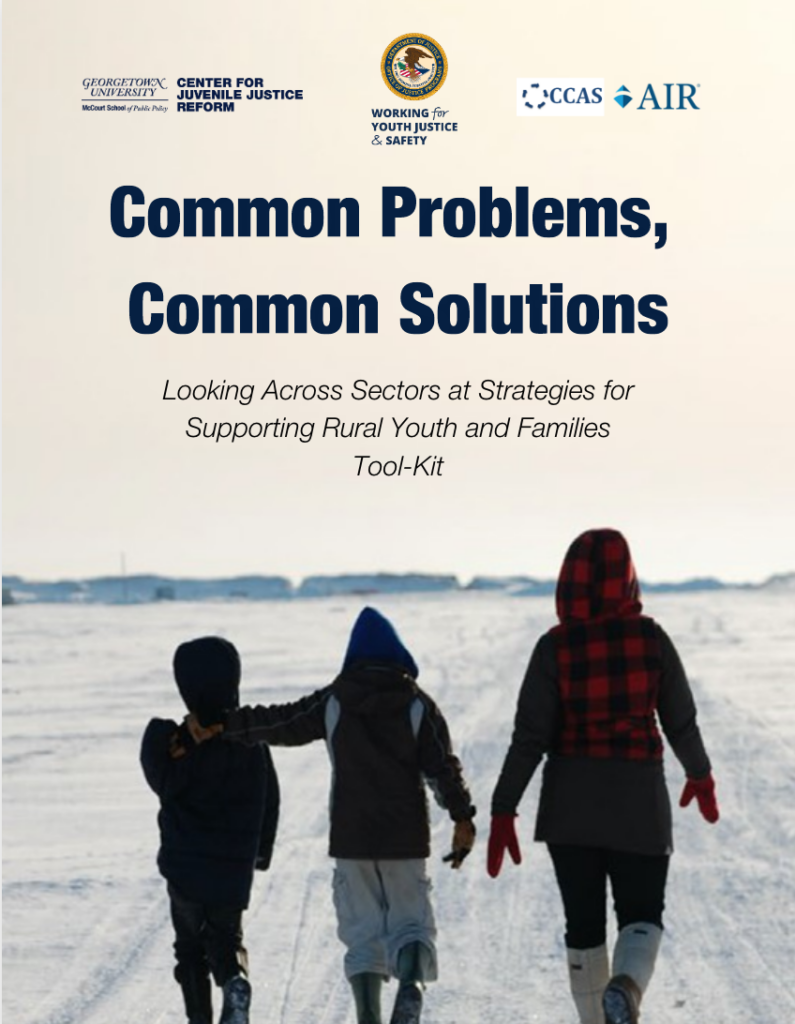
Developed by Lisa Pilnik and Christine Humowitz on behalf of CJJR and in partnership with the American Institutes for Research as part of the OJJDP-supported Center for Coordinated Assistance to States, this tool-kit provides an overview of common barriers faced by rural communities in supporting youth and families as well as innovative strategies to improve outcomes for youth, families and communities. The publication is informed by interviews and listening sessions with practitioners and leaders working in rural areas across the United States.
The Essential Need for Partnering with Youth and Families to Fundamentally Transform Juvenile Probation
2022
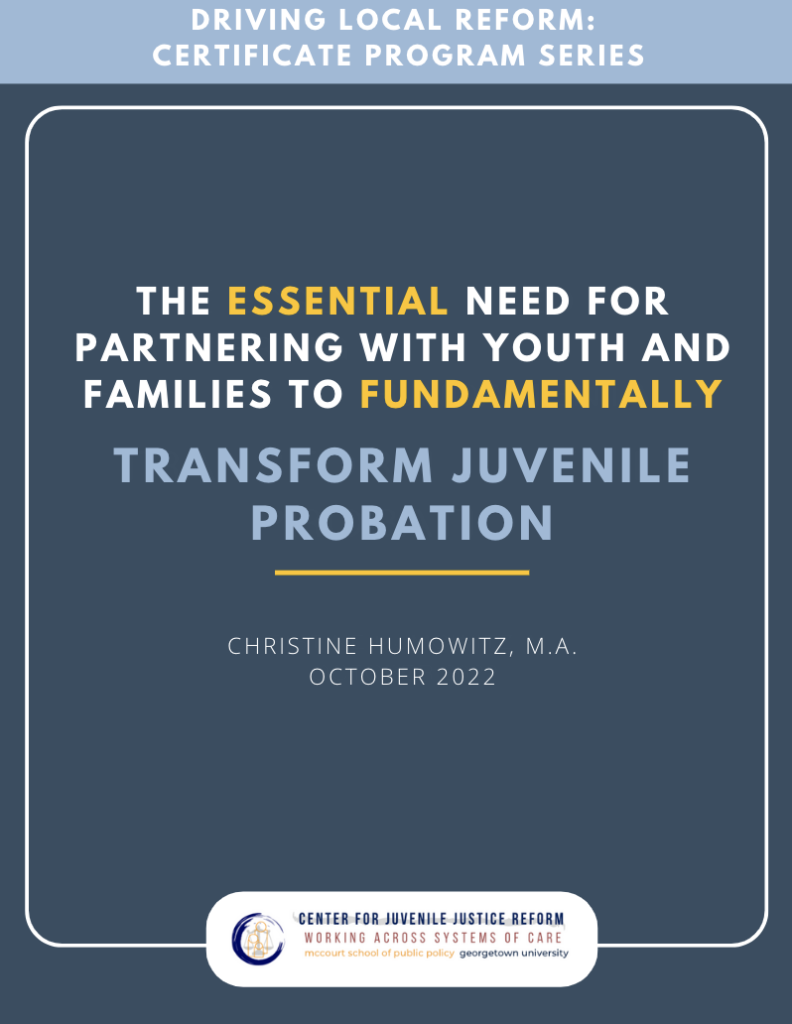
The Center for Juvenile Justice Reform, with support from the Annie E. Casey Foundation, presents “The Essential Need for Partnering with Youth and Families to Fundamentally Transform Juvenile Probation.” In this publication, CJJR’s Christine Humowitz highlights best practices, barriers, and strategies related to actively and authentically partnering with youth and families in the context of juvenile probation. The brief highlights jurisdictional examples from the 2019 cohort of the Transforming Juvenile Probation Certificate Program.
A Trauma-Informed Guide for Working with Youth Involved in Multiple Systems
2022

CJJR partnered with the National Child Traumatic Stress Network to author this resource focused on helping personnel who work with crossover youth and their families to develop a lens toward trauma-informed care. The guide illustrates concepts through two case vignettes and describes practices related to identifying and assessing trauma, developing trauma-informed case plans, identifying appropriate interventions, and managing secondary traumatic stress experienced by providers.
Trauma-Focused Practice Supplement for the Crossover Youth Practice Model
2022

This National Child Traumatic Stress Resource Network (NCTSN) resource was developed by CJJR’s Macon Stewart and Alex Miller in partnership with Tracy Fehrenbach, Julian Ford, and Erma Olafson. The guide is designed for agency staff who are utilizing CJJR’s Crossover Youth Practice Model and/or those who work with dual system youth, and includes real-world examples that highlight five steps to developing trauma-informed practices for crossover youth.
Building Capacity to Support Dual Status Youth in Harris County, Texas: Using Legal Education to Shift Practice
January 2022
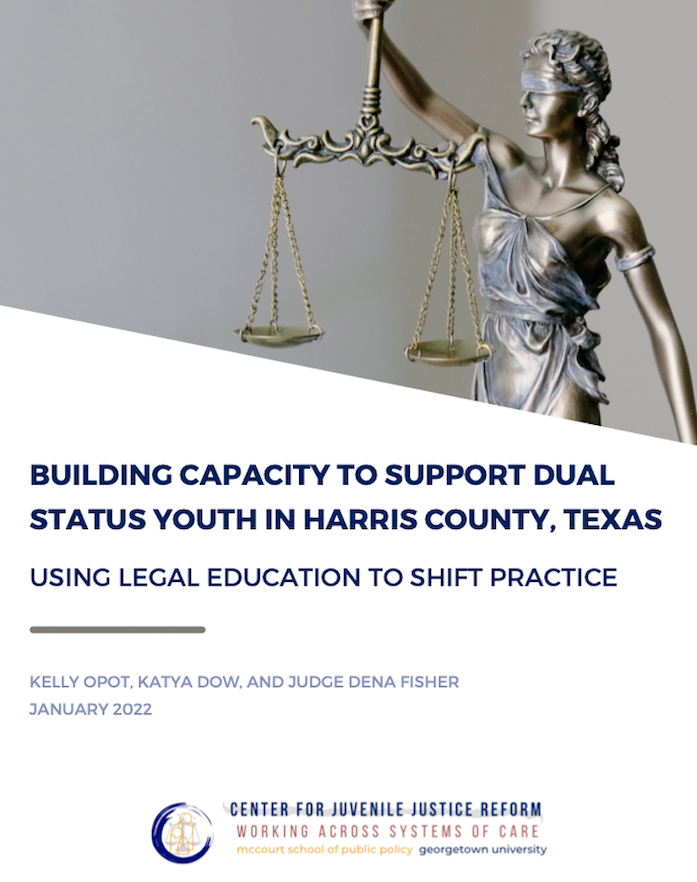
The Center for Juvenile Justice Reform is excited to present a new publication, Building Capacity to Support Dual Status Youth in Harris County, Texas: Using Legal Education to Shift Practice. Authors Kelly Opot, Katya Dow, and Judge Dena Fisher outline efforts to coordinate legal representation and advocacy, including building unique skills among law students, in order to improve legal and system experiences for dual status or crossover youth in Harris County, Texas. The authors explore how collaborative community efforts and the development of a dual status legal clinic have paved the way for stronger service coordination for youth, and for a new pipeline of attorneys committed to bettering outcomes for their dual status clients.
Never Too Early: Moving Upstream to Prevent Juvenile Justice, Child Welfare, and Dual System Involvement
July 2021

The Center for Juvenile Justice Reform presents Never Too Early: Moving Upstream to Prevent Juvenile Justice, Child Welfare, and Dual System Involvement in accompaniment of the 2021 Janet Reno Forum entitled, “A Better Path Forward: Restructuring Systems to Support Crossover Youth.” In this publication, authors Alexandra Miller and Lisa Pilnik demonstrate that to prevent system contact, and to reduce repeated and deeper system-involvement, we must support and work in true partnership with young people, families and communities. Using the Crossover Youth Practice Model as an exemplar, the authors explore programs, strategies, and topics necessary to consider to prevent single- and dual-system involvement.
Reducing System Crossover for Black LGBTQ Girls and Nonbinary Youth
March 2021

The 2021 Janet Reno Forum will explore how to restructure systems to better support crossover youth, centering the conversations on the experiences of youth and families impacted by the juvenile justice and child welfare systems. This includes dedicated Forum sessions examining how to best address the needs of youth, including commercially sexually exploited youth, youth of color, and LGBTQ+ youth.
In advance of these important discussions, this new CJJR publication highlights the critical need to ensure that systems fully support Black LGBTQ+ girls and nonbinary youth–a population that is at higher risk for crossover (i.e., becoming dually-involved in both the juvenile justice and child welfare systems) than their non-Black, non-LGBTQ+ peers.
The white paper also provides recommendations to mitigate this disparity and improve the experiences of and outcomes for this population of young people.
Spotlight Brief: Houston Harris County Youth LEAD
October 2019

The Center for Juvenile Justice Reform is proud to announce its newest spotlight brief, “Houston Harris County Youth LEAD.”Thank you to the Houston Harris County LEAD staff for their information and support in developing this brief. The Houston Harris County Youth LEAD program participated in the seventh cohort of the Multi-System Collaboration Training and Technical Assistance Program which is part of the Office of Juvenile Justice and Delinquency Prevention’s Center for Coordinated Assistance to States. The Center for Juvenile Justice Reform is honored to recognize LEAD’s great work.
A Roadmap to the Ideal Juvenile Justice System
July 2019

The Center for Juvenile Justice Reform is proud to present its newest publication, “A Roadmap to the Ideal Juvenile Justice System.” Authored by Tim Decker, in collaboration with the Juvenile Justice Leadership Network and CJJR staff, this paper lays out the guiding principles and strategies for the ideal juvenile justice system, while providing a plethora of practical examples of these ideals in action.
CYPM Spotlight Report: Harris County Youth Collective
July 2019
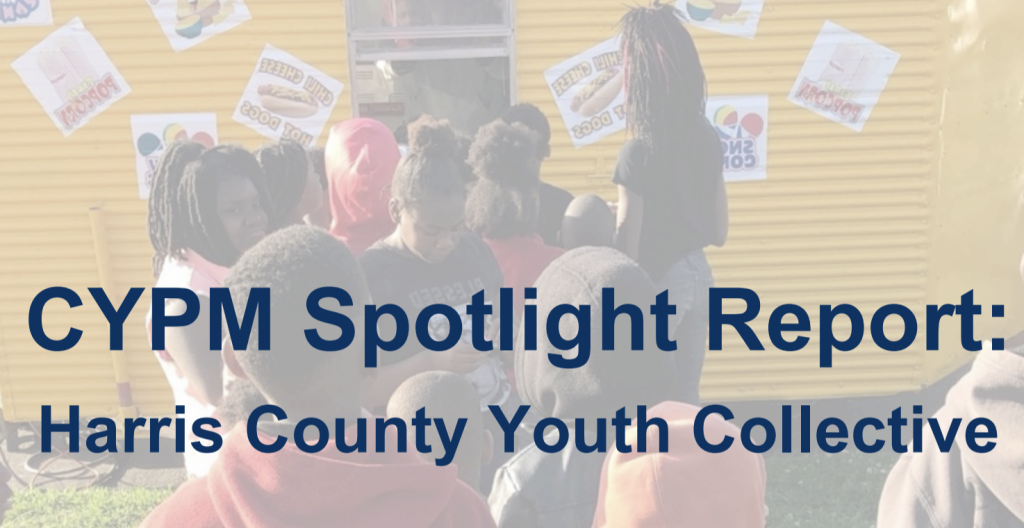
CJJR is proud to announce the release of its latest CYPM Spotlight Report, featuring the Harris County Youth Collective’s youth partnership initiative. Through support from the Houston Endowment, CJJR has partnered with the Harris County Youth Collective (HCYC) to support their Dual Status Youth Initiative. A crucial component of this work is to create true partnerships with youth and young adults who have systems experience. Through meaningful collaboration, HCYC and its youth partners help shift the trajectory of their lives in a positive way and influence broader systems change. This Report highlights the challenges and successes of HCYC’s effort and provides jurisdictions in pursuit of real youth partnership lessons to build upon.
Research Supports Model’s Effectiveness in Improving Outcomes for Youth
January 2019
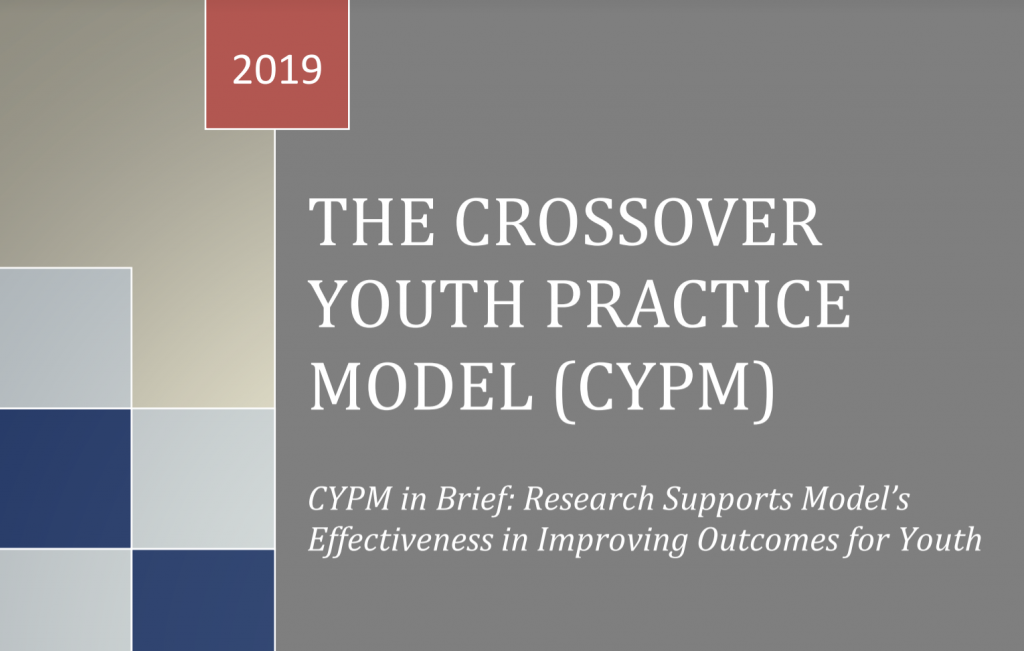
“Research Supports Model’s Effectiveness in Improving Outcomes for Youth” is the latest publication in the CYPM in Brief series. Authored by Hannah McKinney, the brief provides an overview of recent studies that have evaluated the CYPM and the promising results found therein. The brief also reviews the Model’s newest distinction in the California Evidence-Based Clearinghouse for Child Welfare (CEBC). The CYPM received a “3 – Promising Research Evidence” after CEBC’s rigorous assessment. The growing body of work on the CYPM highlights its strengths and effectiveness in improving outcomes for youth involved in the child welfare and juvenile justice systems.
The Protective Potential of Prosocial Activities: A Review of the Literature and Recommendations for Child-Serving Agencies
August 2018

“The Protective Potential of Prosocial Activities: A Review of the Literature and Recommendations for Child-Serving Agencies” is the latest addition to the CYPM in Brief series. Authored by Samuel Abbott and Elizabeth Barnett, this issue brief provides a comprehensive literature review on the impact of engaging youth in prosocial activities, including effects on antisocial behavior and delinquency rates. The brief also includes recommendations for how jurisdictions can support involvement in these activities, using examples from the CYPM for further illustration.
Improving Outcomes for Justice-Involved Youth Through Evidence-Based Decision-Making and Diversion
July 2018

This issue brief, authored by CJJR’s Amber Farn, examines research on structured decision-making processes and juvenile diversion programs, with a focus on using risk and needs assessment tools and disposition matrices to effectively divert youth from the juvenile justice system. The paper also highlights the work of system officials from Fairfax County, Virginia, who facilitated collaboration across multiple youth-serving agencies and used evidence-based decision-making tools to reduce racial and ethnic disparities at the point of system referral.
Consolidated Court Proceedings for Crossover Youth
June 2018
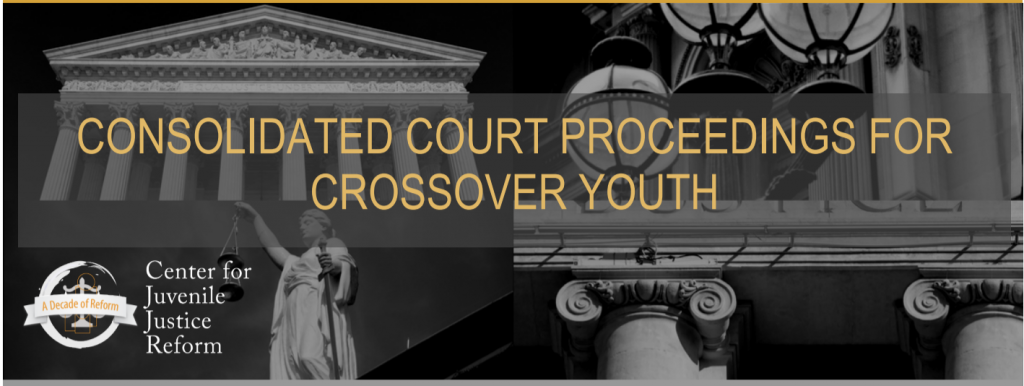
“Consolidated Court Proceedings for Crossover Youth” details effective strategies for processing cases of youth involved in dependency and delinquency matters. This bulletin highlights promising examples of court models that Crossover Youth Practice Model (CYPM) sites have implemented to better serve crossover youth. The strategies discussed in the bulletin are designed to support cross-system collaboration and coordination, lessen burdens on youth and families, and maximize system resources.
Transforming Juvenile Justice Systems to Improve Public Safety and Youth Outcomes
May 2018
This white paper co-authored by CJJR and the CSG Justice Center provides a roadmap of six innovative strategies that states and localities can follow to make sweeping changes to their juvenile justice systems. Facing stubbornly high recidivism rates and limited resources, juvenile justice systems need to reconsider foundational questions regarding who is supervised and served by the system; how those youth are supervised and served; and to what extent agencies and individuals are held accountable for system performance. To begin tackling these questions, CJJR and the CSG Justice Center conducted interviews and focus groups with nearly 50 researchers, national experts, and system leaders to identify innovative ideas for building upon recent system improvements by reorienting juvenile justice systems to improve public safety and outcomes for youth.
Keeping Youth in School and out of the Justice System: Promising Practices and Approaches
May 2018
This bulletin, authored by CJJR’s Amber Farm, focuses on research, strategies, and local reform efforts aimed at reducing school-based referrals to law enforcement and school-based arrests. It also highlights promising examples of school-justice partnerships developed by CJJR’s Certificate Program Fellows through their local Capstone Project reform efforts. These partnerships are designed to create safe and supportive learning environments, improve school responses to disruptive student behaviors, and minimize youth’s juvenile justice system involvement.
Overview of the Evidence-Based Decision-Making Platform and Recent Demonstration Projects
April 2018
Over the past several decades there has been a growing body of research evidence on what works to reduce recidivism and other negative outcomes for youth in the justice system. Equally important has been the development of structured decision-making tools, including risk and needs assessment instruments and disposition matrices. When combined with evidence-based programs and services, these tools can be integrated as components of an evidence-based decision-making (EBDM) platform to support decisions and improve outcomes for youth at every stage of juvenile justice processing.
This bulletin, co-authored by Jill Adams and Madeline Silva, describes the components of the EBDM platform implemented by jurisdictions involved in two recent CJJR demonstration projects, and summarizes key findings from a full report entitled “Juvenile Justice System Improvement: Implementing an Evidence-Based Decision-Making Platform”.
Creating an Integrated Continuum of Care for Justice-Involved Youth: How Sacramento County Collaborates Across Systems
November 2017
Sacramento County is an excellent example of a jurisdiction that, in the past ten years, has strived to develop a more collaborative and integrated continuum of care for youth involved in the juvenile justice and related systems of care.
This brief, authored by CJJR’s Amber Farn and Michael Umpierre, highlights several of the exceptional multi-system reform efforts happening in the county, including: the creation of a dedicated court docket, a memorandum of understanding, and a screening tool to better serve Commercially Sexually Exploited Children; a diversion program that addresses justice-involved youth’s mental health needs; environmental and programming improvements for youth in secure custody; and the implementation of the Crossover Youth Practice Model, a multi-agency initiative created to improve outcomes for youth involved in both the child welfare and juvenile justice systems.
Engaging Court Appointed Special Advocates to Improve Outcomes for Crossover Youth
August 2017
Crossover cases require a high level of collaboration, coordination, and information sharing between parties. They also tend to be resource intensive with high levels of instability and complexity, all while disproportionately affecting youth of color.
This issue brief discusses the role that Court Appointed Special Advocates (CASA) play in the child welfare and juvenile justice systems and how they are involved in the lives of crossover youth. It also describes ways in which the Crossover Youth Practice Model (CYPM) has engaged CASA volunteers and organizations to better serve crossover youth, and provides recommendations on how to best engage with CASA volunteers. This brief is the fourth in a series that addresses various important issues faced by those youth who are dually-involved and the systems that serve them.
A Roadmap for Change: How Juvenile Justice Facilities Can Better Serve Youth with Mental Health Issues
April 2017
Over the past decade, the juvenile crime rate has dropped significantly and the number of youth in the “deep end” of the system (i.e., those committed to correctional agencies and placed in residential facilities) has decreased. These positive advances in the juvenile justice system are bringing a vulnerable population into sharp focus: adolescents suffering from mental illness. System officials around the U.S. report that what was once a mix of low-, moderate- and high-risk youth placed in juvenile correctional facilities is now a population of mostly high-risk youth. Studies consistently find that 65 to 70% of youth in such placements have at least one diagnosable mental health issue.
This article recommends specific improvements to certain policies of the juvenile justice system pertaining to youth with mental health conditions in order to promote more positive outcomes.
Education and Interagency Collaboration: A Lifeline for Justice-Involved Youth
August 2016
Research shows that a high-quality education experience is critical in facilitating youth’s long-term well-being, as the education system provides youth with necessary supports, resources, and skills to become productive members of the society. Unfortunately, literature also suggests that youth involved in the juvenile justice systems often do not have access to the same educational opportunities as their non-delinquent counterparts and tend to struggle with the transition to adulthood. To help systems address the education needs of justice-involved youth, CJJR authored an issue brief, Education and Interagency Collaboration: A Lifeline for Justice-Involved Youth.
This issue brief reviews research on education for system-involved youth, details recent efforts to improve education outcomes for the population, and highlights the Washington Education Advocate Program, a school-based transition program that focuses on bridging the education achievement gap for youth involved in the juvenile justice system in the state of Washington.
CYPM in Brief: Improving Educational Outcomes for Crossover Youth
July 2016
A quality education is an invaluable asset in a child’s life. Educational attainment is an important factor in improving a child’s future income, health status, employment opportunities, and housing stability (Levin, Belfield, Muennig, & Rouse, 2007; Cutler & Lleras-Muney, 2006; Lochner & Moretti, 2001). All children deserve access to a quality education. Unfortunately, children who are involved in the child welfare and juvenile justice systems face a number of significant challenges when it comes to achieving positive educational outcomes. Policy-makers, educators, and child-serving agencies need to be aware of these challenges and make appropriate efforts to support improving the educational outcomes of this unique population.
To aid in these efforts, this issue brief discusses: the relationships between childhood maltreatment, delinquency, and educational outcomes; the ways in which the CYPM addresses educational outcomes; and how jurisdictions that have employed the CYPM have sought to improve educational outcomes for crossover youth. This brief is the third in a series that addresses various important issues faced by those crossover youth who are dually-involved and the systems that serve them.
An Evaluation of the Crossover Youth Practice Model (CYPM): Recidivism Outcomes for Maltreated Youth Involved in the Juvenile Justice System
April 2016
This study examines youth recidivism (reoffending) outcomes of the Crossover Youth Practice Model (CYPM) in an urban county in Minnesota. Crossover youth are defined as maltreated youth who have engaged in delinquency. Decreased recidivism is one of the primary outcomes targeted by the CYPM. Previous internal, exploratory research on recidivism indicates positive outcomes for CYPM youth. In the study, the authors use a quasi-experimental, post-test only design with independent historical and contemporaneous comparison samples. The authors link state-level data from the State Court Information System with the Child Protection Administrative Data and the Automated Report Student System. Youth receiving CYPM services were less likely to recidivate than propensity score matched youth receiving “services as usual” even when controlling for location, time and other key covariates. Study limitations and implications are discussed.
Identifying, Engaging, and Empowering Families: A Charge for Juvenile Justice Agencies
February 2016
Family involvement is an essential element at all points of the juvenile justice system. From arrest to probation, placement, and reentry, families should be respected as partners by the justice system and involved in decisions about their children. For youth in the juvenile justice system, family is best defined broadly to include biological family members, extended and chosen family (including godparents and foster siblings), and other important people such as mentors, teachers, and coaches. Research on the role of family involvement is growing and reflects what juvenile justice staff know through their own experience—youth with strong and diverse support systems have better outcomes.
This white paper reviews the literature exploring the relationship between family contact and short- and long-term outcomes for youth in the juvenile justice system, and identifies ways that agencies—from police through reentry staff—can better engage families in ways that promote both personal contact and active involvement in case assessment, planning, and management.
Youth in Custody Practice Model (YICPM) An Abbreviated Guide
January 2016
The Youth in Custody Practice Model (YICPM) serves as a guide to best practice in youth corrections, identifying over 70 essential policy and practice elements and related outcomes that the model is designed to help participating agencies achieve. Many of these elements and outcomes will not be new to the reader of the YICPM, but what will be groundbreaking is the way they have been pulled together into an overarching construct, with the expectation that they will be implemented in a comprehensive fashion.
The guide is authored by four outstanding leaders in the juvenile justice field: Dr. Kelly Dedel, Dr. Monique Marrow, Fariborz Pakseresht, and Michael Umpierre, who also served as lead editor.
Maltreatment, Child Welfare, and Recidivism in a Sample of Deep-End Crossover Youth
December 2015
Although research has oft-documented a maltreatment–delinquency link, the effect of involvement in—and timing of—child welfare system involvement on offending has received less attention. In this study, the authors examine whether the timing of child welfare involvement has differential effects on recidivism of deep-end juvenile offenders (youth who have been adjudicated delinquent by the court and placed in juvenile justice residential programs). The study uses a large, diverse sample of 12,955 youth completing juvenile justice residential programs between 1 January 2010 and 30 June 2013 in Florida (13 % female, 55 % Black, 11 % Hispanic). Additionally, the authors explore the direct effects of childhood traumatic events on delinquency, as well as their indirect effects through child welfare involvement using structural equation modeling. The findings indicate that adverse childhood experiences fail to exert a direct effect on recidivism, but do exhibit a significant indirect effect on recidivism through child welfare involvement, which is itself associated with recidivism. This means that while having exposures to more types of childhood traumatic events does not, in and of itself, increase the likelihood of re-offending, effects of such experiences operate through child welfare placement.
A Profile of Youth in the Los Angeles County Delinquency Prevention Pilot
December 2015
Children involved in the child welfare system are more likely than other children to be arrested or referred for delinquent offenses. In 2011, the National Council on Crime & Delinquency (NCCD) developed an actuarial assessment, the Structured Decision Making (SDM) delinquency prevention screening assessment, to help the Los Angeles County Department of Children and Family Services (DCFS) identify children at higher risk of subsequent delinquency than other children. The assessment was initially piloted in the fall of 2012 as part of the Delinquency Prevention Pilot (DPP). The following report provides an empirical and theoretical basis for the project, describes the development and implementation of the pilot, and discusses the lessons learned from the process. The report was funded by CJJR through a grant from the Conrad N. Hilton Foundation.
CYPM in Brief: Out-of-Home Placements and Crossover Youth
November 2015
Out-of-home placement (OOHP) refers to the removal and placement of a youth from his or her family environment and into an alternative setting. OOHPs occur in both the child welfare and juvenile justice systems, but under different circumstances. A better understanding of the relationship between OOHP and delinquent behavior would allow agencies to: better target those most at risk of juvenile justice involvement, more effectively utilize in-home and community-based services; inform placement decision-making in the child welfare system; and further educate professionals in both systems to encourage communication and to change practices.
Thus, the objective of this brief is to describe: the role of out-of-home placements in the child welfare system and juvenile justice system and the importance of reducing their inappropriate use; the relationship of OOHPs and delinquency; the “child welfare bias” that a youth with a child welfare system history may face upon contact with the juvenile justice system; the ways in which the Crossover Youth Practice Model (CYPM) addresses OOHP; and how one jurisdiction has addressed OOHP through the implementation of the CYPM. This brief is the second in a series that addresses various important issues faced by those crossover youth who are dually-involved and the systems that serve them.
Crossover Youth Practice Model (CYPM) An Abbreviated Guide
September 2015
The Crossover Youth Practice Model (CYPM) was developed by CJJR to improve outcomes for youth who are dually-involved in the child welfare and juvenile justice systems: crossover youth. The model uses a research-based approach to assist child welfare, juvenile justice and related agencies in adopting policies and practices that better address the needs of these youth and improve their life outcomes.
The primary authors of the Crossover Youth Practice Model are Lorrie Lutz and Macon Stewart, with contributions from Dr. Denise Herz and Lyman Legters. Shay Bilchik edited and provided guidance for the document.
CYPM in Brief: Behavioral Health and Crossover Youth
August 2015
Behavioral health issues, which include mental health and substance use disorders, can significantly challenge the safety and well-being of youth and their families. These risks may be particularly elevated for crossover youth. Due to the potential long-term impact of adolescent behavioral health issues on development and social functioning, it is in the interest of policy-makers and practitioners to monitor and address the behavioral health status of youths in these systems (Keller et al., 2010). In order to assist child-serving practitioners in these efforts, this issue brief will discuss: the relationship between behavioral health and crossover youth, the ways in which the Crossover Youth Practice Model (CYPM) addresses behavioral health, and how one jurisdiction has utilized the CYPM to address behavioral health outcomes. This brief is the first in a series that addresses various important issues faced by crossover youth and the systems that serve them.
Addressing the Needs of Multi-System Youth: Strengthening the Connection between Child Welfare and Juvenile Justice
March 2012
Youth known to both the child welfare and juvenile justice systems–commonly referred to as crossover youth–tend to follow a stealth-like pathway between these two systems. This paper provides a framework for jurisdictions to utilize in their efforts to better serve crossover youth. In this regard, the authors hope that the content presented will help readers develop a better understanding of how to prevent youth from crossing over between systems and ensure that all youth who are served by both the child welfare and juvenile justice systems experience them in a manner that provides for their safety, well being and permanence, while also ensuring public safety.
Safety, Fairness, & Stability for Youth and Families: Recommendations to Strengthen Federal Agency Support of Family Engagement Efforts
September 2011
As a follow-up to Safety, Fairness, Stability: Repositioning Juvenile Justice and Child Welfare to Engage Families and Communities, CJJR and its partners convened a group of federal agency representatives, family advocates, youth advocates, community supporters, and local juvenile justice, child welfare, and judicial leaders to discuss how family engagement can be strengthened at all levels of government. The recommendations from this convening serve as a platform for all entities of government to build or strengthen their work in this area.
Safety, Fairness, Stability: Repositioning Juvenile Justice and Child Welfare to Engage Families and Communities
May 2011
Connections to family and community are often severed, at least temporarily, as a result of a youth’s involvement in the juvenile justice, child welfare, and/or mental and behavioral health systems. Ensuring that these connections are not severed permanently, or are maintained in the first place, begins by engaging families and communities. This paper recognizes that such connections must be supported in a manner that allows families and communities to provide a sense of stability and permanency in a youth’s life and provide the life-long connections that youth will need as they transition into adulthood.
Breakthrough Series Collaborative: Juvenile Justice and Child Welfare Integration
December 2010

This report captures what was learned during the course of the Breakthrough Series Collaborative (a partnership between Casey Family Programs and CJJR) in Baltimore City, Maryland; Denver, Colorado; Georgetown County, South Carolina; King County, Washington; Los Angeles County, California; Miami-Dade County, Florida; and Woodbury County, Iowa.
These communities are to be commended for their willingness to test new ideas and take the next steps in learning what works best to both prevent our young people who have been maltreated from crossing over into delinquent behavior and, if they do cross over, how the two systems can intervene effectively to reduce their penetration into the justice system. The report also sets the stage for the next iteration of this work—institutionalizing this newfound knowledge into routine practice. We hope that the readers of this report not only benefit from the work of the BSC, but also commit to improving their own practices as they relate to crossover youth and the safety, well- being, and permanence of all young people
Improving the Effectiveness of Juvenile Justice Programs: A New Perspective on Evidence-Based Practice
December 2010
This paper presents a new comprehensive approach to evidence-based practice that can help juvenile justice systems enhance the effectiveness of their interventions and achieve more positive outcomes for the youth they serve.
Addressing the Unmet Educational Needs of Children and Youth in the Juvenile Justice and Child Welfare Systems
May 2010 (Second edition released 2012)
This paper outlines potential strategies, programs and resources that will enable political and agency leaders, policymakers, and practitioners to act collaboratively across systems to effectively improve the educational outcomes for youth known to multiple systems of care.
The Nurse-Family Partnership Program: Early Intervention That Works
September 2009
In reaction to the conditions Dr. David Olds saw in Baltimore, Maryland daycare centers during his undergraduate education, he and his colleagues developed and piloted a home visitation program in Elmira, New York starting in 1977. After two more trials, the Nurse-Family Partnership (NFP) was launched in 1996, and today the program exists in 25 states around the country. This paper provides an overview of the Nurse-Family Partnership, a comparison to other home visitation programs, and characteristics of effective home visitation programs.
Supporting Youth in Transition to Adulthood: Lessons Learned from Child Welfare and Juvenile Justice
April 2009
This paper outlines potential strategies, programs and resources that can enable political and agency leaders, policymakers, and practitioners to act collaboratively across systems and to effectively address the issues that crossover youth present when they transition out of care.
Racial and Ethnic Disparity and Disproportionality in Child Welfare and Juvenile Justice: A Compendium
January 2009
Overrepresentation of children of color in the juvenile justice and child welfare systems has been statistically proven in various studies over the years. This compendium includes articles that establish a common language across child serving systems to describe the various problems associated with this overrepresentation and make recommendations for the future.
Bridging Two Worlds: Youth Involved in the Child Welfare and Juvenile Justice Systems, A Policy Guide for Improving Outcomes
2008
There is clear evidence that abused and neglected youth in the child welfare system are at higher risk for subsequent involvement with the juvenile justice system. This publication provides information about this population of “crossover youth” (youth known to both the child welfare and juvenile justice systems), and recommends a policy agenda.
